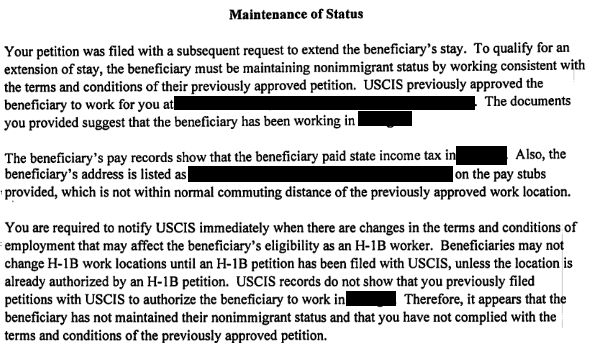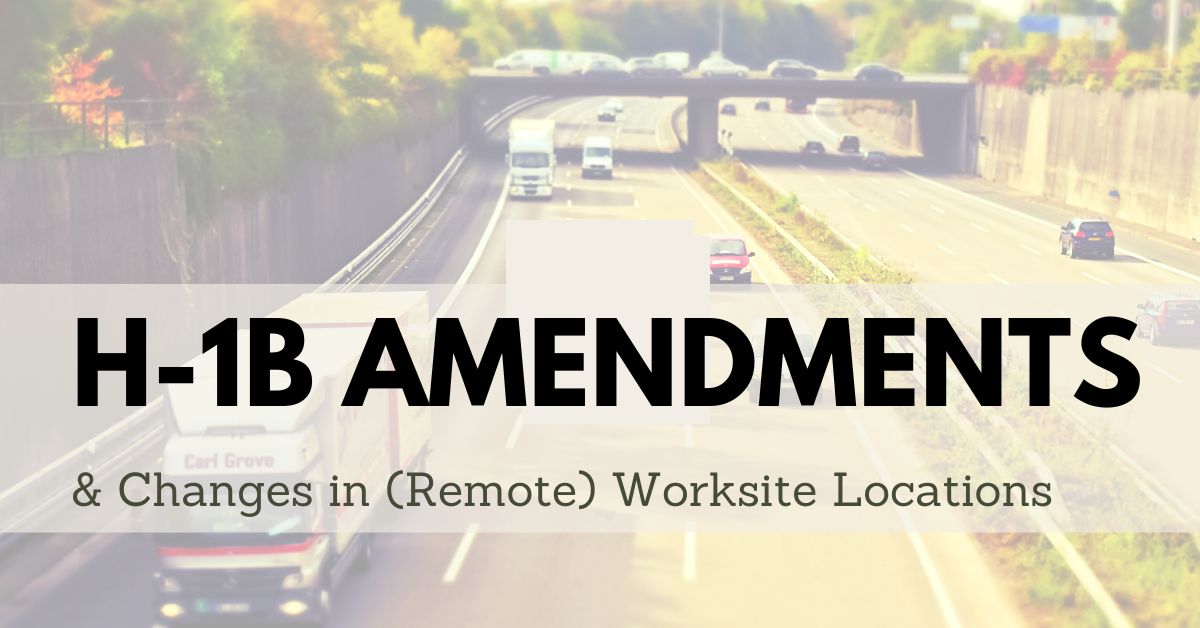Do I Have to File H-1B Amendment When Changing (Remote) Worksite Locations?
With the recent increase of remote or hybrid work arrangements, and the return to office to third-party client sites, we would like to provide a reminder of the relevant H-1B rules for compliance when changing (or having already changed) worksite locations.
Pursuant to the July 21, 2015 Final Policy Memorandum (see our analysis), an H-1B amendment (and not only an LCA) is required any time there is a change in the worksite location. This applies to end client placement situations where there is a change in client and worksite. This rule also applies to remote/home office work when the beneficiary moves to a different home (and thus, to a different home office “worksite”). Here are the details and the exceptions.
First, When is an H-1B Amendment Required?
An H-1B employer must file an amended H-1B petition if the H-1B employee changed or is going to change his or her place of employment to a worksite location outside of the metropolitan statistical area (MSA) or an “area of intended employment” (as defined at 20 CFR 655.715) covered by the existing approved H-1B petition, even if a new LCA is already certified and posted at the new location. In other words, doing an LCA only for the changed worksite location is not sufficient – an H-1B amendment filing prior to beginning work at the new worksite location is required.
Once the amended H-1B petition is filed, the H-1B employee is allowed to start working at the new worksite location. The employer can (but does not have to) wait for the H-1B amendment decision before the H-1B employer can start work at the new worksite location.
Practical Tip.
From practical standpoint, the requirement to have the H-1B amendment filed before the new worksite location placement begins means that the H-1B amendment process should be initiated at least 2-3 weeks (for LCA certification, preparation, signing and filing of the H-1B petition) before the anticipated starting date for the new worksite location placement. Often third-party client requirements require much faster starting date and this H-1B amendment preparation time should be considered carefully. Another practical consideration is that an H-1B amendment for a third-party worksite placement requires documentation of the third-party client – letters, contracts, and similar documents – which are often difficult or slow to get.
When is an H-1B Amendment NOT Required?
The Policy Memorandum has clarified when an H-1B amendment is not required.
The New Worksite Location is Within the Same MSA. If the new worksite location is within the same MSA or area of intended employment a new LCA is not required and, by extension, no H-1B amendment is required. It is important to note that the H-1B employer must still post the original LCA in the new worksite location within the same MSA or area of intended employment.
Short-term Placements. Under certain circumstances, an H-1B employer may place an H-1B worker at a new job location for up to 30 days and, in some cases for up to 60 days (where the employee is still based at the original location), without having to obtain a new LCA for the short-term placement location (20 CFR 655.735). In these situations, the H-1B employer does not need to file an amended H-1B petition (assuming there are no other material changes to the terms of the H-1B petition).
Non-worksite Locations. If the H-1B worker is only going to a non-worksite location and there are no other material changes to the H-1B petition, no H-1B amendment is required. According to USCIS, a “non-worksite location” is:
- when the H-1B worker is going to a location to participate in employee developmental activity, such as management conferences and staff seminars;
- the H-1B worker spends little time at any one location; or
- the job is “peripatetic in nature,” such as situations where their primary job is at one location but the H-1B worker occasionally travels for short periods to other locations “on a casual, short-term basis, which can be recurring but not excessive (i.e., not exceeding five consecutive workdays for any one visit by a peripatetic worker, or 10 consecutive workdays for any one visit by a worker who spends most work time at one location and travels occasionally to other locations).” 20 CFR 655.715.
The Special Case of The Remote Worker Who Changes Home Addresses
One of the most challenging aspects of H-1B worksite compliance over the past few years has been the case of the remote worker who changes homes without necessarily informing their employer. Unfortunately, we have seen employers and H-1B workers fall out of compliance in cases where the H-1B worker decides to move to a different city without necessarily informing their employer. Additionally, we have seen some employers overlook the need for H-1B amendment even when they are aware of the changes in home office worksites.
For home office-based H-1B workers it is important to understand that any changes to the terms of employment, including the actual home office worksite, should be communicated as early as possible in advance to the employer. From the employer’s standpoint, it is important to establish a proactive process of identifying such remote H-1B worker home office changes and ensuring any necessary H-1B amendments (and extensions) are filed timely.
(How) Does USCIS Check and Enforce Failure to File H-1B Amendments Due to Worksite Location Change?
While not extremely common in recent weeks, we have seen USCIS actively look into and enforce the requirement to file an H-1B amendment before a worksite change takes place. Here’s an example of a recent RFE section where USCIS had used information from the petition and from third-party sources to suspect that a required H-1B amendment had not been filed.

This kind of RFE raises a number of challenges because USCIS is alleging that the current H-1B status has not been properly maintained and this may impact the continued ability to work in the U.S. under the current H-1B petition.
What To Do If USCIS Alleges Failure to Timely File H-1B Amendment?
First, it is important to understand whether what USCIS alleges is actually correct. We normally analyze the employment and home office worksite address histories to see when a change in worksite has taken place and whether an LCA/H-1B amendment exception may apply. Sometimes employees list a future (or friend’s) address even though they continue to live closer to or at their worksite and this may provide incorrect impression of the worksite to USCIS. Sometimes USCIS also makes factual mistakes or may not have sufficient information or documents.
If the allegations are correct and an H-1B amendment was required but was not filed timely, it is important to plan very carefully for the remainder of the existing H-1B and the timing of the renewal H-1B RFE response. A denial of an H-1B petition for failure to maintain current status may require the H-1B worker to immediately stop working, leave the US and, in many cases, accrue unlawful presence (which, even if it less than 180 days, will always require disclosure and explanation during visa stamp interviews and which will require always going for stamping at the home country). See our alert on the topic of unlawful presence.
In many similar cases our office has been able to explain that there has been substantive compliance with the LCA/H-1B amendment regulations by providing explanations and documentation. Similarly, it may be possible to simply ask USCIS to NOT consider the “status” component of a petition in their review and to consider the renewal petition under “consular processing”. If this request is granted, it may prevent finding of violation of status (and possibly, unlawful presence) and may allow the H-1B worker time to continue to stay in the U.S. while they prepare the travel abroad and reenter the U.S. using the new approved “consular processing” H-1B petition approval.
Conclusion
We would like to remind that the requirement is that H-1B amendment petitions be filed when there is a change of job location all the time and before the placing the H-1B worker at the new jobsite. This analysis should be conducted even for remote workers and employers should be aware and monitor employees’ home office addresses for compliance.
We are happy to work with our clients to make a comprehensive compliance plan for prompt and cost-effective LCA/H-1B compliance. H-1B employers who routinely place workers at third-party worksites or have remote H-1B workers should consider making such LCA/H-1B compliance plans. Contact us to allow us to evaluate your needs and provide suggestions for compliance planning.
We invite you to subscribe to our free weekly immigration newsletter to receive timely updates on this and related topics. In the meantime, please do not hesitate to contact us with any questions or comments, or if we can be of any assistance with analyzing or filing H-1B petitions, including amendments.
Related News and Articles
The Capitol Immigration Law Group has been serving the business community for over 15 years and is one of the most widely respected immigration law firms focused solely on U.S. employment-based immigration. Disclaimer: we make all efforts to provide timely and accurate information; however, the information in this article may become outdated or may not be applicable to a specific set of facts. It is not to be construed as legal advice.

